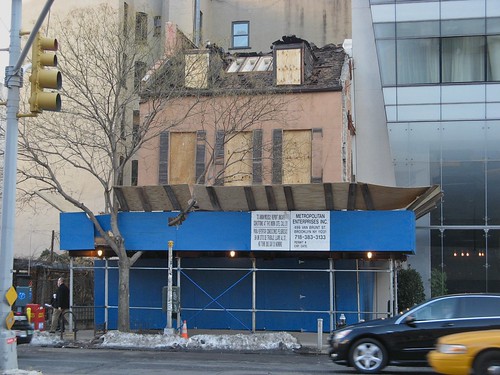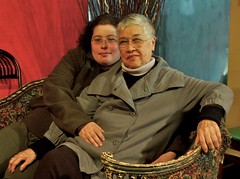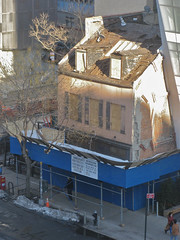 Tim Milk As the historic site at 35 Cooper Square faces the prospect of demolition, the building’s last tenants – Hisae Vilca, and her granddaughter, Rachel Lindenberg (below), who operated the 35 Asian Pub – recalled their memories of working and living in the oldest building on Cooper Square.
Tim Milk As the historic site at 35 Cooper Square faces the prospect of demolition, the building’s last tenants – Hisae Vilca, and her granddaughter, Rachel Lindenberg (below), who operated the 35 Asian Pub – recalled their memories of working and living in the oldest building on Cooper Square.As preservationists make last-ditch efforts to keep 35 Cooper Square standing, its last tenants, Hisae Vilca, and her granddaughter, Rachel Lindenberg, retraced their own history in the little house and the pub Ms. Vilca ran on the ground floor for the past five years while she lived upstairs.
“I love everything old, including me. I love antiques, and I loved that building,” said Ms. Vilca, 77, who came to New York from her native Japan five decades ago and who customers fondly called “Grandma.” She opened the bar, a neighborhood favorite, in 2006. “I had a very sentimental attachment to the house. Some of the other people were just tenants. But for me, it was a different kind of attachment,” she said.
The federal-style house, built around 1825, is under threat of demolition after the developer Arun Bhatia began construction there on Feb. 4. A Stop Work Order has been in place since Feb. 14 because of a broken fence at the back of the site, and inspectors found two violations, for failing to publicly display a work permit and failing to properly protect the public and nearby property.
Closing day on Jan. 29 brought customers and staff to tears, Ms. Vilca said. “They were all crying. I had customers, young and old, who would come every day, rain or shine. The last day, everybody’s crying and getting drunk,” she said, “I had to go upstairs.”
Ms. Lindenberg, 27, who helped her grandmother run the spot, working behind the bar and checking IDs, said, “The manager was up on the bar, weeping. I thought it would be there forever.”
After shuttering the doors to the bar for the last time, the next day, Ms. Vilca cleaned out the upstairs rooms where she’d made a cozy home for 10 years with her husband Juan, 65, and granddaughter.
Ms. Lindenberg spent her late teens living on the top floor, where Stanley Sobossek once lived and painted. “I loved the brick and the smell of the place. There was a lot of light. I loved the beautiful, exposed, cedar beams that held up the roof. They were dark and aged, red and a rich brown in color. If I closed my eyes I could imagine it, and almost smell the oil of Sobossek’s paint,” she said. Downstairs, her grandmother lived with her husband.
The family has been attached to the house since Ms. Vilca opened her first restaurant there, Hisae’s Place, in 1976. “My lawyer said, ‘Don’t go to the East Village because nobody’s going to come,” laughed Ms. Vilca, who decided to test the culinary waters in the East Village, anyway.
She comes from the island of Hokkaido in Japan, and moved to New York in the 1960’s, after coming to the U.S. in 1954 as the wife of a G.I., her previous husband and Ms. Lindenberg’s grandfather. She remembers the seediness of Cooper Square and the Bowery in the late 1970’s. “When I came over there, it was terrible. They had $5 male hookers outside. It was dark and they used to pick pocket,” she said. The interior of the house was extremely run down. “The building was in pretty bad shape. I could pick up a brick out of a wall and you could see outside. It looked like a Western movie. There was a lot of dark, old wood. There wasn’t even a kitchen.”
She installed a kitchen and made other interior changes over the years so that she could run a business and live with her family upstairs. “I didn’t destroy anything. I fixed it up and tried to keep its character. I went in with a shoestring and didn’t have any credit. Whatever money I made at lunchtime, I would use that to buy food for serving dinner.”
Hisae’s Place was opened in the space where Mr. Sobossek, the artist, who she said owned the building at the time, was running a pub. He used the upstairs as a studio. “I have some of his paintings. He was an excellent artist,” she said, “but artists can’t run a business.” So they struck up an arrangement: “We made a deal. He could eat there every night and have a drink for free,” in exchange for allowing Ms. Vilca to run a restaurant.
 Suzanne Rozdeba Demonstrators held a protest last month to oppose the planned demolition of the building.
Suzanne Rozdeba Demonstrators held a protest last month to oppose the planned demolition of the building.“Outside, the area was very dingy. But inside, it was warm and homey,” she said. Ms. Vilca had to renovate the lopsided stairs so she and her family could get up to their living quarters and back down safely. Asked how Mr. Sobossek got up and down the rickety stairs, she just shrugged. “He had one wooden leg, you know,” she said.
Ms. Vilca ran the eatery for 13 years, and counted Jacqueline Kennedy Onassis, Mick Jagger, and Dick Clark as some of her famous customers. In 2000, she opened another restaurant there called Dolphins, which she owned for about six years, and then transformed the space into the Asian Pub.
Ms. Lindenberg remembered fondly a Sept. 11, 2001 mural that community members painted on the north side of the house after the tragedy but it was painted over in 2004 by Cooper Union, the former building owners, to the anger of many community members. “I helped work on that,” she said, “I got up on the scaffolding to paint. Everybody in the community was volunteering. A lot of love and effort was put into that.” At Ms. Vilca’s BBQ, a restaurant she owns in the West Village, a photo of the mural hangs on one of the walls.
Tiffany Bank, 29, a longtime customer of Asian Pub, followed Ms. Vilca to BBQ, where she reminisced this past Friday night about her affection for the bar. “I would come from Harlem to the Asian Pub three times a week. It was my ‘Cheers,’” she said. “I was devastated when I found out it was closing. When I was unemployed, Hisae took care of me and fed me until I found a job. She never let me pay a dime.”
Ms. Vilca said, “All my customers, they had a lot of energy and kept me young. I met so many people.” But seeing big investments in hotels and condominiums in the neighborhood, and increased interest in the property signaled to her that the end could be near for the little, brick house. “You sort of knew it was coming. I hate to see it go down.”
And so does her granddaughter, who said, “While that chapter of my life is closed, every time I hear that the Stop Work Order is still in place, I cheer. That place had heart.”





